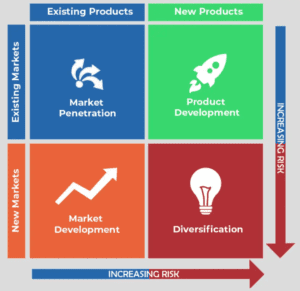What is it?
The Ansoff Matrix, also known as the Product/Market Expansion Grid, is a strategic planning tool used by businesses to devise growth strategies. It was developed by Igor Ansoff, a Russian American mathematician and business manager. The matrix provides a framework for evaluating and planning growth strategies based on two key dimensions: products and markets.
The four growth strategies outlined in the Ansoff Matrix are:
- Market Penetration: This strategy involves selling existing products to existing markets. It aims to increase market share through strategies like price adjustments, increased marketing, or product improvements.
- Market Development: In this approach, a company seeks to introduce existing products into new markets. This might involve expanding to new geographic regions or targeting different customer segments.
- Product Development: Companies pursuing this strategy focus on developing new products for existing markets. This can include innovations, extensions of product lines, or improvements to existing offerings.
- Diversification: This strategy entails entering new markets with new products. It is the riskiest option but can offer significant growth opportunities if successful.
Businesses use the Ansoff Matrix to assess their growth options and make informed decisions about which strategy aligns best with their objectives and risk tolerance. It’s a valuable tool for strategic planning and helps organizations navigate the complexities of business expansion.

How do you use it?
The Ansoff Matrix is a versatile tool for strategic planning, helping businesses determine their growth strategies. Here’s how to use it:
- Understand the Matrix: Familiarize yourself with the four quadrants of the Ansoff Matrix:
- Market Penetration: Selling existing products to existing markets.
- Market Development: Introducing existing products to new markets.
- Product Development: Creating new products for existing markets.
- Diversification: Entering new markets with new products.
- Assess Your Current Position: Determine where your business stands in terms of products and markets. Identify your current products and target markets.
- Set Objectives: Define your growth objectives. Are you looking to increase market share, expand into new markets, innovate with new products, or explore entirely new areas?
- Evaluate Growth Strategies: Consider the following strategies based on your objectives:
- Market Penetration: Increase marketing efforts, offer promotions, or adjust pricing to gain more market share.
- Market Development: Research new markets, assess demand, and create strategies to enter them.
- Product Development: Innovate, create new product variations, or improve existing products to cater to customer needs.
- Diversification: Research and analyze new market opportunities and develop new products or services for them.
- Risk Assessment: Evaluate the risks associated with each strategy. Market penetration is typically the least risky, while diversification carries the highest risk.
- Strategy Selection: Choose the growth strategy that aligns with your objectives and risk tolerance.
- Implementation: Develop a detailed plan for executing your chosen strategy. This should include marketing campaigns, resource allocation, and timelines.
- Monitor and Adjust: Continuously monitor the progress of your strategy and adjust as needed. Be prepared to pivot if market conditions change.
- Feedback Loop: Incorporate feedback from the market and internal stakeholders to refine your strategy over time.
- Repeat the Process: As your business evolves, revisit the Ansoff Matrix to explore new growth opportunities and adapt your strategy accordingly.
Example
Let’s use a chocolate shop as an example to explain how to apply the Ansoff Matrix for growth strategies:
1. Understand the Matrix:
- Market Penetration: Selling more of your existing chocolate menu items to your current customer base.
- Market Development: Introducing your existing chocolates to new customer segments or geographic areas.
- Product Development: Creating new chocolate variations or innovative toppings for your current customers.
- Diversification: Expanding into new food-related ventures, like offering pasta dishes or launching a food delivery service.
2. Assess Your Current Position: Your chocolate shop currently offers a range of classic chocolates in a specific location, serving your local community.
3. Set Objectives: You want to increase revenue and expand your customer base while maintaining your reputation for quality chocolate.
4. Evaluate Growth Strategies:
- Market Penetration: You could increase your sales by offering loyalty programs, special deals, or expanding your dine-in and takeout services.
- Market Development: Consider opening a second location in a nearby town or targeting a new demographic, such as college students or families.
- Product Development: Create new chocolate flavors, gluten-free options, or unique toppings to attract both existing and new customers.
- Diversification: Explore options like adding pasta dishes to your menu or partnering with a food delivery platform to reach a wider audience.
5. Risk Assessment:
- Market penetration is relatively low risk since it involves selling more of what you already offer.
- Market development and product development carry moderate risk, as they require research and potential changes to your menu.
- Diversification is higher risk, as it involves entering entirely new markets or business areas.
6. Strategy Selection: Based on your objectives and risk tolerance, you might decide to focus on market development by opening a new location in a nearby town.
7. Implementation: Develop a business plan, secure a new location, hire staff, and market your shop to the new community. Maintain quality and consistency to retain loyal customers.
8. Monitor and Adjust: Continuously track sales, customer feedback, and market trends. Adjust your menu, marketing, or services based on what works best.
9. Feedback Loop: Listen to customer comments, reviews, and suggestions to refine your offerings and service quality.
10. Repeat the Process: As your second location grows, revisit the Ansoff Matrix to explore further expansion or diversification opportunities.
Using the Ansoff Matrix, you can systematically plan and execute growth strategies to expand your chocolate shop business while managing risks and staying aligned with your objectives.